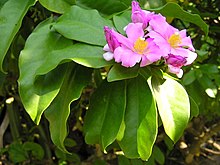Rhodocactus grandifolius
| Rhodocactus grandifolius | |
|---|---|

| |
| Scientific classification | |
| Kingdom: | Plantae |
| Clade: | Tracheophytes |
| Clade: | Angiosperms |
| Clade: | Eudicots |
| Order: | Caryophyllales |
| Family: | Cactaceae |
| Genus: | Rhodocactus |
| Species: | R. grandifolius
|
| Binomial name | |
| Rhodocactus grandifolius | |
| Synonyms[1] | |
| |
Rhodocactus grandifolius (rose cactus; syn. Pereskia grandifolia) is a species of cactus native to eastern and southern Brazil. Like all species in the genus Rhodocactus and unlike most cacti, it has persistent leaves. It was first described in 1819. It is grown as an ornamental plant and has naturalized outside its native range.
Description
[edit]Although Rhodocactus grandifolius is a cactus by classification, it takes the form of a shrub or small tree, 2–5 m (7–16 ft) in height, exceptionally 10 m (33 ft). Young twigs are green or reddish with conspicuous white spots marking the stomata. It has trunk has grayish-brown bark and has a diameter of up to 20 cm (8 in). The areoles are rounded, cushion-shaped, and with grayish or brownish tomentum. On the twigs, they are 3–7 mm (0.1–0.3 in) across and up to 12 mm (0.5 in) on the main trunk. The areoles can have one to three or occasionally four leaves (brachyblast leaves) in addition to spines. The spines range from black to brown, the number at each areole gradually increasing with age; new twigs can have spineless areoles, while the trunk areoles may have up to 90 spines, each 2–6.5 cm (0.8–2.6 in) long. The leaves vary in size, and are usually from 9–6.5 cm (3.5–2.6 in) long, but can be shorter or up to 30 cm (11.8 in) long. They are entire, with shapes ranging from elliptic to ovate and obovate-lanceolate. The dense inflorescence develops at the ends of stems and also laterally from the areoles of upper parts of the main shoots and twigs. It usually has 10-15 flowers, but sometimes has 30 or more. The flowers which may be pale pink through to purplish-pink are showy and rose-like, about 3–5 cm (1.2–2.0 in) across. The fruit is very variable in size and shape, and is green, yellowish or reddish-green when ripe. It contains many glossy black seeds.[2]
-
Habit, in cultivation
-
Spines on stems
Taxonomy
[edit]The species was first described by Adrian Hardy Haworth in 1819 as Pereskia grandifolia. It was transferred to Rhodocactus as R. grandifolius by Frederik Marcus Knuth in 1936.[3] However, this was not accepted by most botanists, and Rhodocactus was sunk into a broadly circumscribed Pereskia. Molecular phylogenetic studies from 2005 onwards suggested that with this circumscription, Pereskia was not monophyletic, and consisted of three clades.[4][5][6] In 2016, the genus Rhodocactus was revived for one of these clades, which included R. grandifolius.[6]
Varieties
[edit]Two varieties are accepted:[1][2]
- Rhodocactus grandifolius var. grandifolius is distinguished by having green bracts and green to pink sepal-like perianth parts.[7]
- Rhodocactus grandifolius var. violaceus (Leuenb.) I.Asai & K.Miyata has purplish-pink or purple bracts and sepal-like perianth parts, and somewhat smaller petal-like perianth parts than var. grandifolius.[7] It was discovered sometime before 1972, initially described as Pereskia bahiensis, but is only distinguished by colour.[2]
Distribution
[edit]The species as a whole is native to eastern and southern Brazil. It is widely cultivated in other parts of South America, the West Indies and beyond, and has become naturalized in some of these countries, including Vietnam.[1] R. grandifolius var. grandifolius has a similar distribution; R. grandifolius var. violaceus is apparently native to Espírito Santo and Minas Gerais, but is cultivated in neighbouring states.[2]
Uses
[edit]Rhodocactus grandifolius is grown as an ornamental plant, appreciated for its flowers. It is also used as a hedge.[2] Its leaves can be eaten as a salad or used in stews.[8]
References
[edit]- ^ a b c d "Rhodocactus grandifolius (Haw.) F.M.Knuth". Plants of the World Online. Royal Botanic Gardens, Kew. Retrieved 2021-05-04.
- ^ a b c d e Leuenberger, Beat Ernst (1986). Pereskia (Cactaceae). Memoirs of the New York Botanical Garden. Vol. 14. Bronx, NY: New York Botanical Garden. pp. 111–118. ISBN 978-0-89327-307-1. Retrieved 2021-05-02.
- ^ "Rhodocactus grandifolius (Haw.) F.M.Knuth". The International Plant Names Index. Retrieved 2021-05-04.
- ^ Edwards, Erika J.; Nyffeler, Reto & Donoghue, Michael J. (2005). "Basal cactus phylogeny: implications of Pereskia (Cactaceae) paraphyly for the transition to the cactus life form". American Journal of Botany. 92 (7): 1177–1188. doi:10.3732/ajb.92.7.1177. PMID 21646140.
- ^ Bárcenas, Rolando T.; Yesson, Chris & Hawkins, Julie A. (2011). "Molecular systematics of the Cactaceae". Cladistics. 27 (5): 470–489. doi:10.1111/j.1096-0031.2011.00350.x. PMID 34875796. S2CID 83525136.
- ^ a b Asai, Issaku & Miyata, Kazunori (2016). "An Emendation of Rhodocactus, a Genus Segregated from Pereskia (Cactaceae)" (PDF). Journal of Japanese Botany. 91: 7–12. Retrieved 2021-04-25.
- ^ a b Anderson, Edward F. (2001), "Pereskia grandifolia", The Cactus Family, Pentland, Oregon: Timber Press, pp. 568–569, ISBN 978-0-88192-498-5
- ^ Reyes, Andrés E.L. (1998). "Pereskia grandifolia Haw". Trilhas da ESALQ (in Portuguese). Escola Superior de Agricultura "Luiz de Queiroz", Universidade de São Paulo. Retrieved 2021-05-04.


